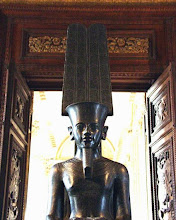Row over Nefertiti bust continues
And now it went fron internal Egyptology to BBC News.
 The bust was unearthed by a German in 1912 |
She was rumoured to be the world's most beautiful woman in her time.
Nefertiti, Queen of Egypt, was the co-ruler of her country in the 14th Century BC. Today, the bust of Nefertiti (whose name literally means "a beautiful woman has arrived") has pride of place in the Antiquities collection in Berlin's Altes Museum.
Her face features on postcards of the city and each year, thousands of visitors flock to the museum to admire the ancient treasure.
But, once again, the bust of Nefertiti is the subject of a heated debate, as it appears the Egyptians want it back.
The head of the Supreme Council of Antiquities in Egypt, Zahi Hawass, recently said the Egyptian Foreign Ministry would send letters to Germany requesting that the treasure should be loaned temporarily to Egypt.
This latest announcement has opened a can of worms as the German government has refused to give it back.
'German property'
The bust of Nefertiti was unearthed at Amarna in Egypt by a German archaeologist, Ludwig Borchardt, in December 1912. It's thought the bust was made around 1350BC.
Back in 1912, the excavation was financed by a Berlin philanthropist, James Simon. Nefertiti's bust was then taken to Germany under the terms of an agreement reached in 1913.
According to both museum officials and the German government, it is definitely German property. The treasure has been on public display in Berlin since 1923.
![]()
![]() It is an enormous risk to let her travel. We could never be certain that she would arrive in good health
It is an enormous risk to let her travel. We could never be certain that she would arrive in good health ![]()
Curator, Berlin Egyptian Museum
"Nefertiti's face is an icon of beauty, and the bust is the ultimate symbol of female beauty," says Dietrich Wildung, the curator of Berlin's Egyptian Museum.
"But it is an enormous risk to let her travel. We could never be certain that she would arrive in good health. There are serious conservation issues. The bust is made of limestone and thick layers of plaster and it's very sensitive to vibrations, shock, and any change of temperature," he said.
The German Culture Minister, Bernd Neumann, has also supported the position of museum officials. Mr Neumann said the bust of Nefertiti was too fragile to travel and he reiterated "that there were no doubts about the legal ownership of the priceless artefact.

"Experts have reservations about taking Nefertiti on a long trip, and we have to take these concerns seriously," said Mr Neumann in a statement.
Bizarrely enough, a campaign has now been launched in Germany called "Nefertiti Travels".
The new initiative was launched by a cultural association based in Hamburg, CulturCooperation.
They have written an open letter to the German Culture Minister, Bernd Neumann, urging him to offer the statue to Egypt on loan.
![]()
![]() I think Egyptians should have the chance to see the bust of Nefertiti in Egypt
I think Egyptians should have the chance to see the bust of Nefertiti in Egypt ![]()
"For the last 95 years, Berlin has insisted that the ownership of Nefertiti's bust is legally perfectly clear," says CulturCooperation's Lena Blosat.
"The Germans claim that Nefertiti has become an integral part of our cultural identity here in Germany, which we are not prepared to part with. And the Egyptians say she is our Egyptian Queen and thus part of our culture.
"Today, even allowing the bust to be exhibited in Egypt for three months is an issue which museum directors are obviously not willing to discuss," she said.
Campaigners have distributed postcards depicting the bust of Nefertiti with the words "Return to Sender."
'Best ambassador'
"I think Egyptians should have the chance to see the bust of Nefertiti in Egypt. They shouldn't have to travel all the way to Germany to admire their country's cultural assets," says Alexander Schudy, who works for a group called the Berlin Network for Development Co-operation.
"Nefertiti is not a unique case. There are many works of art in Germany which have a dubious past, and it's about time that we address this topic so that we can have a fair and honest debate," he says.
But museum officials are adamant that the bust of Nefertiti will not return to Egypt.
"I think Nefertiti is the best ambassador of Egypt. She is accepted here, although she is still unique and different. She must stay in Germany," says Dr Wildung, the curator of the Egyptian Museum.
As I stand and admire the bust of Queen Nefertiti, wearing her distinctive blue crown, I am struck by her enigmatic smile. I wonder what she would have made of all this fuss.Source






